
After 136 years on Springfield’s north end, a family tradition comes to an end
EDUCATION | Will Burpee
“Good morning! Today is Thursday, May 17,” said St. Joseph’s School principal Linda Tusek into the intercom one recent morning. She began with the day’s announcements to students and teachers, then delivered the day’s “Caring Message,” centered around that week’s theme of “character:” “Anne Frank said, ‘Parents can only give good advice or put their children on the right paths, but the final forming of a person’s character lies in their own hands.’ Now please stand and join in the morning prayer....”
Following the prayer, Tusek concluded, “Please continue your prayers in your individual classrooms. Have a good day, and remember to be kind to one another.” So began another day at St. Joseph’s, much as it has throughout the school’s long existence. But this would be one of the last days for the daily ritual, because after 136 years on Springfield’s north end, the school is ceasing operation.
According to the 1870 U.S. Census, Springfield had a population of 17,364. The city’s north end was growing rapidly, aided in part by such industries as the Illinois Watch Factory at North Ninth Street and North Grand Ave., and Rolling Mills, North Eleventh and Ridgely. Amid this setting, in 1876 the north end and its predominantly Irish working-class population, got its first Catholic church, and the city’s third overall, with the founding of St. Joseph’s Parish, on the corner of North Sixth and Eastman streets. The church opened on Christmas Day, 1877, the same year an affilliated four-room school was built. The original structure, known as “the Scout Hut” for its many years hosting Boy Scout meetings, still stands.
Just north of the new church and school were the Ursuline Sisters, founded in 1857, who opened a convent, as well as Springfield’s first Catholic school, originally at Sixth and Mason. They moved north 10 years later. Ursuline Academy continued at 1400 N. Fifth for well over a century until closing in 2007. In 1892, the nuns began staffing the new St. Joseph’s school, and went on to provide teachers for other Catholic schools in the city. In 1910, the school moved into a new three-story building at Fifth and Eastman. That would be their home for the next 76 years, with one brief interruption.
In the early morning hours of May 14, 1949, the school was seriously damaged by fire. “We walked into this building and honestly, all that was left was just the shell,” recalled Sister Rosaire Lazzari in 1991 in an article in the State Journal-Register. “You could look up and see the sky.” No one was injured, but the interior had to be completely restored, and the top floor was removed. In the meantime, classes were held at Ursuline, the nearby Springfield Junior College (now Benedictine University of Springfield) and Cathedral Boys’ School (a predecessor to Sacred Heart-Griffin School).

The
fall of 1956 saw a new addition, which became the main school building
in 1986 with the demolition of the original structure, as well as a new
gymnasium. Through the years, St. Joseph’s went from being staffed by
nuns, to largely lay teachers. Michael Lelys was the first secular
principal, in 1974, as were two of the three who followed him. The
school, which for decades had drawn its student body almost exclusively
from its north end parish, has, in recent years, had students from
around the city, as well as from a few nearby communities. And, as with
other Catholic schools in Springfield and nationwide, attendance has
gradually declined. From some 500 students in the 1960s, enrollment has
trended downward – from almost 200 for the 2000-01 school year, to a
projected 82 for this fall, with only three of those enrolled in
kindergarten.
St.
Joseph’s has had a history of several generations of families attending.
A good example were Gary and Mary Faxon, who were wed at St. Joseph’s
church. In doing so, Gary married into a family whose children have
attended the school all but two years since 1959. The tradition
concluded with son Benjamin as one of 17 students in the class of 2012.
“I’ll miss the tradition and sense of community,” said Faxon. “We’ve
shared it with other church and school families. There’s a lot of strong
bonds. We were hoping our grandchildren would attend.”
Another
parent, Michelle Bretscher, cited the decline in nuns teaching and the
closure of the Ursuline convent several years ago as a turning point:
“When the convent closed, their tradition of service declined. There
wasn’t that constant interaction anymore.” She noted its status as
Springfield’s oldest Catholic school, and lamented, “It’s a shame that
tradition has to be cast aside.”
One
person especially active in maintaining the school’s sense of community
didn’t even have any children in the school. Jim Moser has been a
parishioner for more than 20 years, and has been a regular presence
around the school in numerous ways. Originally assisting in yard work,
Moser went on to help supervise the playground, and to walk several
children home every afternoon. “I’ll miss the kids,” he said. “When I’m
not here, the kids ask about it.”
Moser
also cites the departure of the nuns and the convent’s closing as
contributing factors in the school’s demise: “It used to be the schools
were free to the parishioners because the nuns did most of the teaching,
and it was considered part of their duties.” The decline in Catholic
school enrollment concerns him, noting, “St. Joe’s almost certainly
won’t be the last school to close.”
The
Rev. Msgr. Thomas Holinga has been at St. Joseph’s Church since 2002,
long enough to witness the most recent slide in enrollment. Even the
figure of some 200 students that year, he said, “included an influx of
some 30 students from St. Cabrini’s when it closed that year. There’s
been a considerable decline ever since.” It was serious enough for the
Springfield Catholic Diocese to commission a study by the National
Catholic Education Association in 2007 as to how the decline might be
reversed. Among its conclusions were that there were two too many
schools in town for the population, out of the then seven Catholic
elementary schools in operation. (The others are St. Aloysius, St.
Agnes, Blessed Sacrament, Cathedral, Little Flower and Christ the King.)
One proposal would have had another north end school, St. Aloysius,
merging with St. Joseph’s, but nothing came of it.
The school added several
new programs in an effort to market itself. Probably the main drawing
card was an accelerated classes program, in English and in literature,
for students in seventh and eighth grades. It was also the first school
in the diocese to offer a balanced calendar, where the school days were
spread out over 12 months, instead of the traditional nine. Also offered
were Spanish classes at all grade levels, intersession and summer
programs, a science lab, and the incorporation of technology through
everything from laptops for students to the development of the school’s
website. All these programs were well-received, with the accelerated
classes program especially receiving national recognition. But they
failed to stem the tide.
Even one of the best things about St.
Joseph’s
was ultimately a factor in its closing, according to Holinga: “Our
small class size was a strength, but it was also a weakness.”
Amie
Meneghetti, morning personality at WQQL (“Cool 101.9”) is a St.
Joseph’s alumna who spent the maximum nine years there, from
kindergarten to eighth grade. As schoolchildren often do, she hit it off
with one teacher in particular: “I had Sister Monica in first grade,
and we bonded well. I ended up taking her name as my confirmation name. I
visited her at the Ursuline convent almost weekly until she died in the
late 1980s.” But Sister Monica wasn’t the only nun Meneghetti remembers
fondly: “The nuns were some of the best teachers I’ve ever had. They
were so dedicated, so patient, so good at what they did.” She recalled
the school in general as “a warm, easy learning environment.”
It’s a description Jennifer Burke would no
doubt second. When she joined the school as its principal in 1996 for a
15-year-run, she said, “Everyone was so friendly and welcoming, and
those first impressions of the students, staff and families increased my
enthusiasm even further.” As much as the school’s faculty and its
numerous academic offerings, Burke spoke warmly of the numerous
activities and events, as well as day-to-day things, such as “...daily
conversations
with students and volunteers in the cafeteria, the hugs and stories from
the younger students...junior high students on what was happening in
their personal lives, and graduates who would visit over the years just
to stay in touch.” She left in 2011 to be a stay-at-home mom, but said
of her old job, “I am so proud to be a part of the 136year history of
this institution.”
Of
the teachers at St. Joseph’s, few can match Mickie LaFata, not only for
her longevity (34 years), but for her family’s involvement with the
school and the church:
“My mother-in-law, Stella
LaFata, was school secretary, and the computer lab is named for my
father-in-law, Sylvester LaFata.” She, her husband, children and
grandmother have all been active at St. Joseph’s, the fourth generation
of her family to do so.
She
began in 1977 in the old building, moving into the newer structure when
the old one was razed in the mid-eighties. Starting with a second-grade
class, she moved on to many years as kindergarten teacher, switching to
first grade in 2003. Her kindergarten classroom, which she designed
herself, was the last in the new building to be completed. “It had lots
of electrical outlets,” she said, “and a sink and bathroom geared to
children. I missed all those outlets when I moved into my firstgrade
classroom.”
LaFata
taught many students in her 34 years at St. Joseph’s, and said, “I hope
I’ve touched them in some way. I’ve taught more than one generation of
the same family.” She remembers one student in particular, for tragic
reasons. Kelley McConnell was five years old when she joined LaFata’s
kindergarten class in 1994, from there going to first grade. It was
there that she developed stomach pains, and near the end of the 1995-96
school year she was diagnosed with leukemia. “It was less than a month,”
said LaFata sadly, “from there to her death.” Until the school’s
closing last week, a memorial plaque hung in the school lobby, reading,
in part, “May our Special Angel always help us to spread our wings and
fly.”
Of the some 80 students who would have attended St. Joseph’s next year, about eighty percent are going to other
Catholic schools. The lion’s share of those will go to St. Agnes or St.
Aloysius. A handful of other students are set to attend public schools.
The passing of 136 years of school at Fifth and Eastman, in all
likelihood, ultimately could not have been avoided, given the long-range
trends at work. But it’s little solace to those who have given their
all to the St. Joseph’s community, and in the process formed lasting
bonds and associations.
Mickie
LaFata expressed that as well as anybody, sitting one day last week in
her all-butempty classroom, saying, “It’s very sad. This is
family...It’s our life. I don’t know how to explain it other than that.”
She and her colleagues leave with sadness, but also with considerable
pride: “We’ll hold our heads high.
This is what we’ve taught our children.”
Will
Burpee is a freelance writer from Springfield and was a crossing guard
at St. Joseph’s from January 1992 to May of this year.